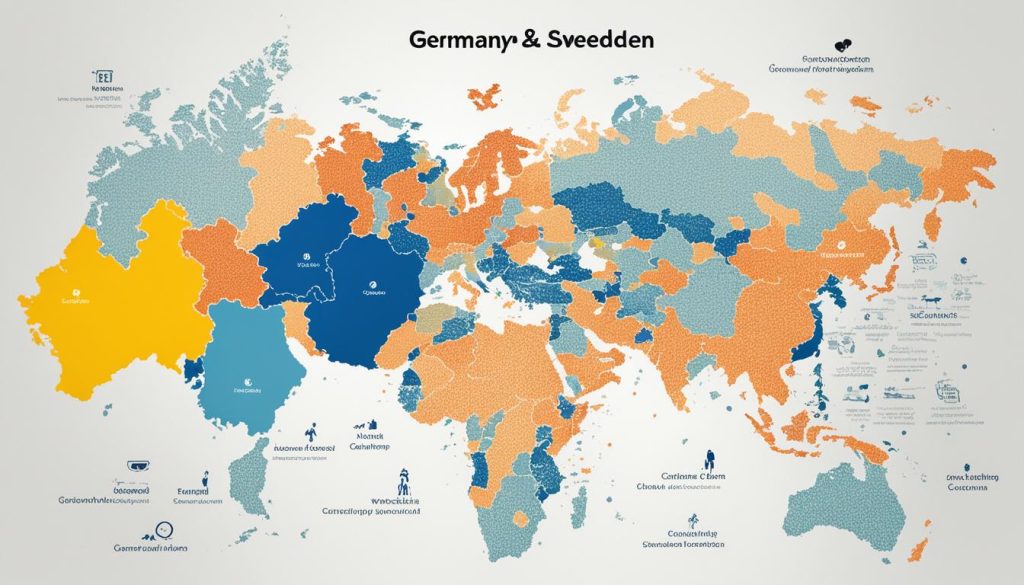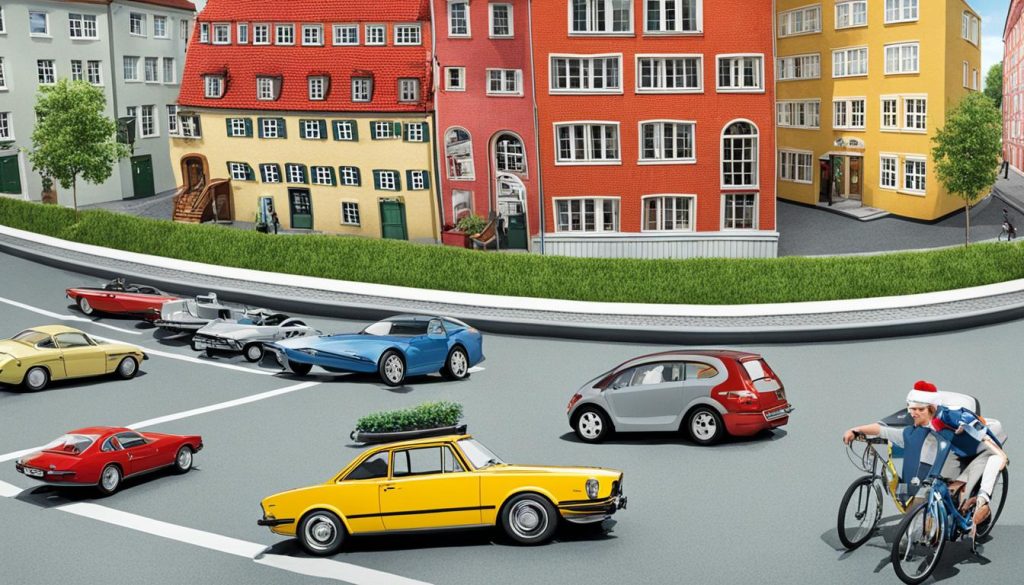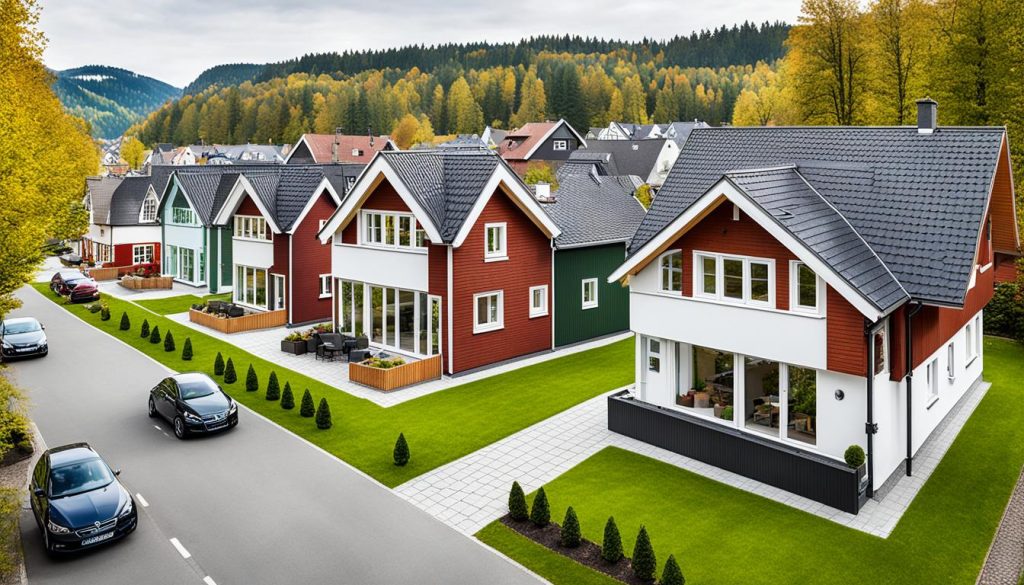Comparing life in Europe means looking closely at Germany and the Nordic countries. This isn’t just about who lives better. It’s about understanding how different economic conditions affect daily life. Germany’s strong industries contrast with the Nordic focus on social welfare. These differences shape how people live in each area.
We need to consider things like population, the economy, and how well the countries are built. These factors show us how living standards differ or match up. By studying these, we get a clearer picture of what life is like. It helps us see the good and the tough parts of living in Germany or the Nordic countries.
An Overview of Germany and the Nordic Nations

Europe shows a clear contrast between Germany and the Nordic nations, especially Sweden. Germany is known for its strong federal system. Sweden, on the other hand, has a monarchy system. Let’s look at what makes these countries different in Europe.
Geographical and Political Contrasts
Germany is at Europe’s heart, a mix of many cultures and central to politcs and economy. Meanwhile, Sweden enjoys peaceful Northern landscapes and focuses on welfare policies. The governance in each country matches their location; Germany is a busy crossroad, Sweden values unity.
Demographic Disparities
Germany and Sweden’s populations are very different. Germany has about 83 million people, making it denser than Sweden. Sweden has a smaller population of around 10 million. These differences impact how each society is organized.
- Population Density: Germany’s cities are bustling; Sweden’s towns are more spread out, showing how living experiences differ.
- Life Expectancy: Swedes live longer, showing the strength of their healthcare and lifestyle.
- Migration Rates: Both countries attract migrants, influencing their societies in unique ways.
The contrast between Germany and Sweden isn’t just in numbers. It shows how life varies in these two distinct areas, rich in heritage yet uniquely diverse in their demographics.
Dissecting the Economic Structures: Germany Vs Nordic Countries

Exploring the economies of Germany and the Nordic countries offers deep insights. Both are known for their strong economies. Yet, looking closer at their economic models helps us understand what drives their success.
GDP and Economic Growth
Germany is a leading economic force in Europe, thanks to its high GDP. The Nordic countries also show strong economic growth but have a lower GDP in comparison. These figures change over time, showing how economic power shifts between them.
- GDP comparison between Germany and its Northern counterparts reflect the intricate dynamics of economic potency and market resilience.
- Capital investment, scientific research, and technological advancements continue to fuel Germany’s financial engine, contributing to its inflexible economic stature.
Unemployment Rates and Inflation
Looking at unemployment helps us gauge a country’s job market health. Germany sees low unemployment, signalling its strength in creating jobs. Nordic countries, despite higher unemployment, often have higher average incomes. This sparks discussions on job market performance and life quality.
- The interplay between unemployment trends and inflation rates is critical to understanding the health of an economy.
- Economic structures are further shaped by the principles of supply and demand, with inflation directly impacting consumers’ purchasing power and lifestyle affordability.
In conclusion, Germany and the Nordic countries have varied yet complex economies. They each have their own strengths and face different challenges. The mix of GDP, employment, and inflation paints a detailed picture of their economic landscapes.
Scrutinising Quality of Life Indicators

When thinking about life quality, we explore things like healthcare, education, and how wealth is shared. These aspects help us figure out how good people’s lives are. Germany and Sweden have made good progress here, but they differ in some ways.
Healthcare Systems and Life Expectancy
In healthcare, Sweden leads with more doctors for its people than Germany. This could explain why Swedes live longer. Getting medical help is key to a long, healthy life. Sweden’s healthcare system plays a big role in its high life expectancy.
Education and Literacy Rates
Sweden works hard to keep its education top-notch, spending a lot on it. High literacy in both countries shows their commitment to education. This prepares their people for today’s world.
Income Levels and Distribution of Wealth
Looking at how wealth is shared tells us about a country’s economy. Germany and Sweden are wealthy but share their riches differently. This insight adds to our understanding of their economic health, highlighting the value of each citizen.
- Germany’s economy is strong, aiming for fair wealth sharing.
- Sweden focuses on sharing wealth equally, helping it score high in life quality.
The contrast between these nations offers insight into life’s quality there. It reveals the small differences that affect everyday life.
The Cost of Living: A Comparative Analysis

When looking at money matters in Germany versus Sweden, living expenses stand out. They show if a place is good economically and for personal wellbeing. The comparison leans towards Germany for being more affordable. It’s important to understand what this means for managing daily budgets.
In Germany, the living cost index is at 82.26%, less than Sweden’s 93.88%. This cost comparison shows different daily expenses. These include food, housing, travel, and fun activities. But what exactly goes into these numbers?
- Housing and Utilities: Rent, electricity, gas, and water services.
- Transportation: Public transport fares, vehicle ownership costs, and fuel prices.
- Food and Beverages: Grocery bills, dining out, and alcohol prices.
- Healthcare: Medical services, dental care, and pharmaceuticals.
- Clothing and Personal Items: Apparel, footwear, and accessories.
- Recreation: Sports, hobbies, and cultural events.
These costs are key to understanding the affordability of a place. They affect life quality. In the Nordic area, higher costs might limit how much people can save. We provide a graph below to show these cost comparisons.
Understanding living costs goes beyond just numbers. Things like currency value, economic policies, and social support also play a part. Regardless if you’re in Berlin or Stockholm, the mix of expenses is crucial to discuss in today’s economy.
Employment Opportunities in Germany and Nordic Countries

Exploring the job scenes of Germany and Nordic areas gives us important ideas about jobs and careers. We must look closely at job market trends and personal growth chances. This helps us understand how well these places can support a strong work environment.
Job Market Fluidity
Germany’s job scene shows it’s easier to find work there than in some Nordic places. This ease hints at a very active and changing job market. Different industries in Germany offer various job chances. This makes Germany stand out in Europe’s job market.
Professional Growth Prospects
In Sweden, pay is usually better than in Germany, even though more people have jobs in Germany. The higher pay in Sweden suggests good chances for career and personal growth. Sweden shines as a place for finding fulfilling career paths.
- Germany’s competitive job market ensures a variety of employment openings across diverse industries.
- Sweden’s attractive salary prospects hint towards a rewarding environment for career advancement.
Germany and Sweden offer different perks and challenges for work seekers. Germany is known for job security, while Sweden attracts with its high salaries. This shows the importance of considering various factors when thinking about careers in these European areas.
The Housing Markets: A Factor in Quality of Living

Exploring the housing market helps us understand the quality of living. In places like Germany and the Nordic countries, the state of the housing market affects real estate comparison and property affordability. It shows us the broader residential trends. The importance of housing markets goes further than just finding a place to live. It influences a nation’s economy, its society, and how happy people are.
- Understanding housing supply and demand tells us how open and inclusive the community is.
- Looking at housing affordability and incomes helps us see if people can afford homes.
- Reviewing the variety of homes available tells us about a country’s architecture and modern living trends.
Figuring out exact measures without deep data is hard, but housing markets clearly tell us about quality of living. The relationship between house prices, rent, and what people earn tells us a lot about a place’s socio-economic health. So, looking at living costs and average earnings helps us indirectly review housing in these European areas.
- Checking if there is enough housing for everyone, like young workers, families, and older people is vital.
- Watching housing price trends helps predict what might happen in the market next.
- Thinking about how green and sustainable houses are shows how forward-thinking a market is.
In the end, the condition of the housing market in Germany and Nordic countries reflects their wider economic and social situations. It lets us see how living standards in these European areas compare, giving us a unique view of their lifestyle.
Cultural and Lifestyle Differences Impacting Living Standards

We look into Germany and Sweden’s rich cultures. Their languages, social habits, and communities create a vivid picture. Cultural differences and lifestyle changes are key in understanding living standards. Knowing and adjusting to these norms is crucial for everyone living there.
Languages and Communication Barriers
In Germany, languages like German, Turkish, and Russian are common. In Sweden, people speak Swedish, Finnish, and more. Overcoming language barriers is vital for fitting in. It helps in getting jobs, using public services, and making friends.
Social Norms and Community Life
Getting used to local habits and social rules is needed in both countries. Germany and Sweden have different community vibes. Both celebrate many cultural events and value community. This makes people feel they belong. They also share a respect for Christianity and other religions.
- Germany’s cities show a mix of different cultures.
- Sweden’s collective way of living shows in its welfare.
- Language learning shows efforts to include everyone in the culture.
Living in these countries means embracing local ways. It’s about adding to the cultural story of these places. This makes both societies richer.
An Ecological Perspective: Comparing Environmental Policies

When we look at environmental policies, we must consider how a country’s actions affect nature. Comparing Germany and the Nordic countries shows us a lot. We see differences in their pollution levels and energy use. These differences highlight their dedication to protecting nature and how their policies affect the world.
Germany, known for its big industry, has put out a lot of CO2 in the past. This shows a big effect on nature that needs strong policies to fix. The Nordic countries, praised for their focus on a green future, have cut down their CO2 emissions. They use smart and broad sustainability actions.
- Assessment of CO2 Emissions
- Comparison of Renewable Energy Initiatives
- Energy Production and Consumption Patterns
Recently, Germany has made its environmental policies stronger to fight climate change. They’re using more renewable energy now. This new direction is about lessening the harm from their old ways of using fossil fuels. The Nordic countries keep leading with their focus on green tech and renewables. They’re influencing worldwide policies.
Both areas are looking into renewable energy, like wind and solar power, and its effects. These actions show they both care a lot about the environment. They’re trying to find ways to keep the Earth healthy while also growing their economies.
The policies these countries choose don’t just shape their own nature areas. They also help set global goals for being green. As Germany changes its policies and the Nordics keep leading, we learn how to balance making money and keeping the planet safe.
Evaluating the Infrastructure: Transportation and Technology

The backbone of a nation’s growth often lies in its transportation and tech areas. Germany and Sweden are great examples of how to plan for future travel and communication. They invest a lot in public transport and new tech to make travel smoother and communication faster.
Investments in Public Transport and Roadways
Germany and Sweden lead in making transport easy and widespread. Germany has its famous autobahn and trains connecting cities. Sweden focuses on green solutions like electric roads and biofuel buses. Here’s a look at their transport systems:
- Conventional and high-speed trains that shrink distances and travel times
- Public bus services that connect remote areas promoting inclusivity
- Well-maintained roads and bridges to ensure safety and uninterrupted flow of commerce
- Bicycle lanes to encourage healthy lifestyles and reduce carbon footprints
Advancements in Telecommunication
Telecommunication ties our society together. Germany and Sweden stand out globally by investing in tech. Their high-speed internet encourages digital business and innovation.
- Extensive broadband and mobile network coverage catering to ever-growing data demands
- 5G trials and roll-outs, setting the blueprint for the next technological revolution
- Public Wi-Fi hotspots to enable access to information on-the-go
- International connectivity hubs that ensure smooth global information exchange
Germany and Sweden shape the future of transport and communication. Their constant development shows a deep dedication to progress. They stand out in enhancing our ability to move and stay connected.
Comparing Social Services and Social Security
Looking into the social services and social security in different countries, we see interesting things. Germany and Sweden offer insights. Both are known for strong social policies that aim to protect their citizens. Yet, their ways of offering these services differ.
In Germany, ‘social insurance’ is key to its welfare system. It includes benefits like pensions and health insurance. This supports people at various life stages and economic situations. It helps keep a high living standard.
Sweden adopts a ‘welfare state’ model, aiming for universal access to services. It offers wide-ranging healthcare, education, and child care, all based on social equality. Its social security is generous, especially with parental leave and pensions.
-
Germany’s Social Security System: Emphasis on Insurance-Based Benefits
-
Sweden’s Welfare Model: Focus on Universal Coverage and Equality
-
Impact on Populace: Analysing Citizen Well-being and Satisfaction
In comparing welfare systems, we look at what they offer and how easily people can use them. We also think about how well they meet needs and if they’re financially sustainable. These points help us see the impact on society.
It’s hard to tell which system is better due to many factors. However, both Germany and Sweden do well in providing social services. They see social security as key to society. This approach helps them support a good living standard for people. Their strong welfare commitment makes them stand out internationally.
Analysing Climate Factors in the Quality of Living
Climate greatly affects our quality of life. Each country has its own climate challenges that impact daily life, mood, and health. Some people love the heat, while others prefer cooler air. The efforts made to adapt to seasonal changes show how much a country values resilient communities.
Seasonal Variations and Impacts
In Germany, warmer days and more humidity contrast with Sweden’s cooler, rainier weather. These differences shape how people live, from what they wear to how they heat their homes. It shows how adaptable we can be, facing varied weather patterns and their effects on mood and well-being.
Climate Change Adaptation Policies
Addressing climate change requires smart adaptation. Germany and Sweden have strategies to lessen climate change’s negative effects. Their commitment helps communities face an uncertain future. It’s all about promoting a sustainable way of living.
The Public Perception: Happiness and Overall Satisfaction
Exploring public perception and happiness index, we see they are linked with life satisfaction. In Germany and the Nordic countries, many factors affect this. Not just numbers, but the feeling in the streets and homes shows a deep-seated happiness.
The Germany vs. Nordic contentment debate isn’t just about numbers. It’s about political stability, civil rights, and health service efficiency. Together, these shape what people think and feel. Let’s look into the aspects that play into this view:
- Political stability is key to happiness in society. Germany and the Nordic countries are doing well here.
- Having and protecting civil rights makes people feel valued. This boosts public perception.
- Good healthcare is crucial for happiness. Both areas offer high-quality healthcare.
- Education and job chances support quality of life satisfaction.
- Environmental care and sustainability are important in the Nordic regions. They are leading in this.
Together, these factors create a rich tapestry of life. You feel wellbeing just walking through Berlin or enjoying Stockholm. This shows in the happy vibe from people around. It’s this mix of factors that builds complete societal satisfaction.
Understanding happiness and satisfaction is like solving a big puzzle. Social security and being eco-conscious are crucial. They help show how Germany and the Nordic countries make their people’s wellbeing a priority.
Navigating the Education Systems: Opportunities and Outcomes
In looking at the education systems in Germany and Sweden, it’s clear they stand out. They offer lots of academic opportunities and welcome students from all over. This makes European education very attractive to students worldwide.
Accessibility of Education
Germany and Sweden make education easy for everyone. They have no tuition fees for public universities. This makes learning accessible to all. It creates a place where people love to learn and share knowledge.
International Student Populations and Policies
International students find these countries inviting. They can stay to work after finishing their studies. This approach brings new ideas to the classroom and workplace.
- Scholarship programmes enhancing the affordability of advanced study
- Student support services ensuring a conducive learning environment
- Opportunities for internships and research linked with industry needs
- Clear immigration guidelines facilitating the transition from study to employment
The education systems in Germany and Sweden open many doors. They link learning with career goals and cultural understanding. They keep improving to meet the needs of all students.
Taxation and its Role in Economic and Social Wellbeing
Taxation plays a key role in keeping an economy stable and society thriving. For example, Germany and Sweden manage taxes and spending well, with rates at 48.80% and 49.10% respectively. This small difference shows how both countries ensure their people can enjoy a good standard of living. By taxing incomes, nations can determine how well their citizens live.
Taxes do more than just support the economy; they help society too. In Germany and Sweden, tax money helps provide important services. These include healthcare and education, which are key for a community. These policies make sure taxes are fair and used well to improve everyone’s life.
In Germany, the tax system helps international students too. They can earn some money without paying tax, which helps them study and work. This makes Germany an attractive place for students from around the world. Smart tax policies support the economy and make the country more diverse and interesting.







